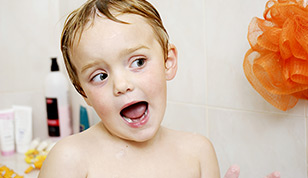Blog Categories
Search Blog
Blog Categories
Tips to Build Language in Everyday Situations
Part 2: Talking During Bath Time
Does this ever happen to you? You come home from a long day of work, make dinner, eat, clean up, rush the kids upstairs for their bath and bedtime, and put them to sleep, only to realize that you barely actually had a conversation with your children? If so, you are NOT alone. Families often come into their weekly speech therapy sessions and report that they “didn’t have time” or “couldn’t squeeze in” their 10-15 minutes of “homework” each day.
We understand that with today’s fast pace schedules, it’s hard to find a designated speech practice time, every single day. That is why last year we began our series of tips to build language into everyday situations by looking at ways to promote language during grocery store visits. This blog will focus on another one of life’s regular routines: BATH TIME!
Bath time is a great opportunity to build your child’s language, no matter what their age or language level. Here are some practical tips that can be used during bath time:
1. Build Concept Knowledge: Having a vocabulary of basic concepts helps to improve comprehension and encourages the use of more detail when describing things. There are a number of concepts that can easily be taught and discussed, in a concrete way, during bath time.
- Full/Empty: Look at the bathtub before filling it with water. Discuss how it is empty. As the water fills the bath, comment on the fact that it is filling up. As your child gets into the bath, ask him/her to tell you if it is now empty or full. You can also work on full/empty as you fill different bath toys with water and dump them out.
- Wet/Dry: Have a variety of bath toys available for this activity. Once you are ready for “playtime” in the bath, pick up each toy, one by one, and have your child tell you if it is wet or dry. Ask him/her the same question after you have dropped the toy into the bath. By having lots of toys, it will give your child many opportunities to practice identifying wet/dry. As your child gets out of the bath, comment on how he/she is wet, but will soon be dry after using a towel.
- Clean/Dirty: Just like with the bath toys, we want many opportunities to practice these concepts. Instead of quickly washing your child, try washing one body part at a time. Have your child identify which body parts are clean (already washed) and which are still dirty (yet to be washed).
- Hot/Cold: Once your child is in the bath, run a washcloth under water of different temperatures and have your child touch the washcloth and identify if it is hot or cold. For older children, you can make this harder by using a larger variety of temperatures (e.g., cold, cool, warm, hot).
2. Action Words: Building your child’s action word vocabulary can help him/her construct new and unique sentences. There are many different action words that can be modeled during bath time.
- Wash: As stated above, to give your child many opportunities to practice this word, you can breakdown bath time and wash each body part one at a time. Model short phrases like “let’s wash your hair”. Emphasize “wash” as you wash each part.
- Squeeze: Have a variety of objects for your child to squeeze during bath time. Sponges and washcloths are great examples. Your child can also help squeeze the soap or shampoo bottles. Model the word “squeeze” as you do the action to make learning concrete.
- Rub: Model “rub” when rubbing hands together with soap. You can also label “rub” when bath time is finished and you are drying off with a towel.
- Pour: Fill up containers of different sizes and pour water into the bath. Have your child say “pour” as he/she does this. You can also fill a jug with water and pour water on different body parts, one at a time, to wash off the soap/shampoo.
3. Sequencing: Being able to sequence the steps of routines is an important precursor to telling stories. Our stories are confusing if we can’t tell the events of what happened in the appropriate order. Bath time is a highly structured routine. The steps of bath time always occur in the same (or very similar) order. This makes bath time an ideal routine to practice sequencing.
- Talk about what you are doing as you are doing it. Use words such as first, next, then, and finally, as you describe what’s happening (e.g., first we fill the bath with water, next we get undressed, then we get into the bath, etc.).
- Once your child is able to retell the sequence in order, see if he/she can tell you the sequence of events BEFORE bath time.
- Once bath time is finished, have your child retell the steps, in order. Cue him/her with reminders, if he/she requires help.
By following these simple suggestions, you will be able to turn bath time into language learning time. Just remember – every routine is an opportunity to learn language. Stay tuned for future blogs in this series, including: meal time, story time, and bed time. For now, happy washing and talking!






